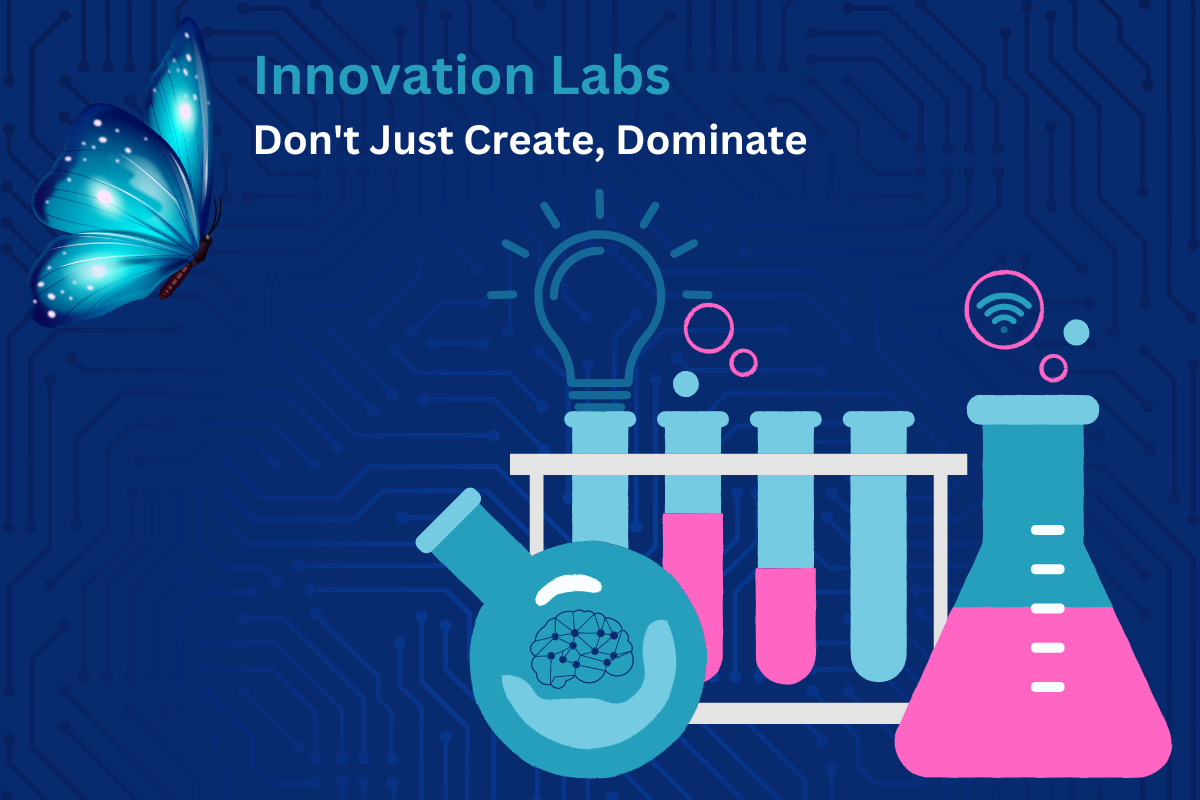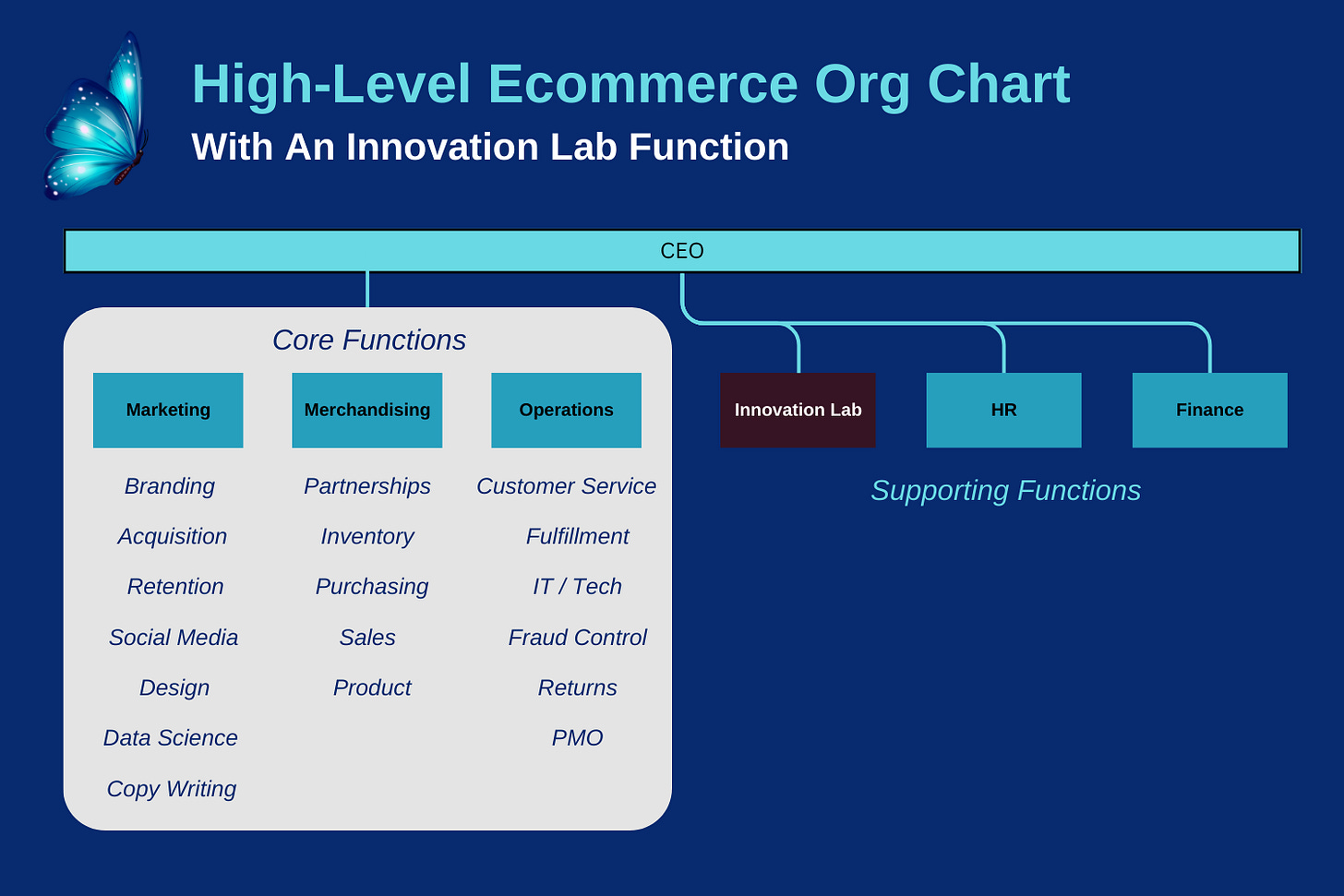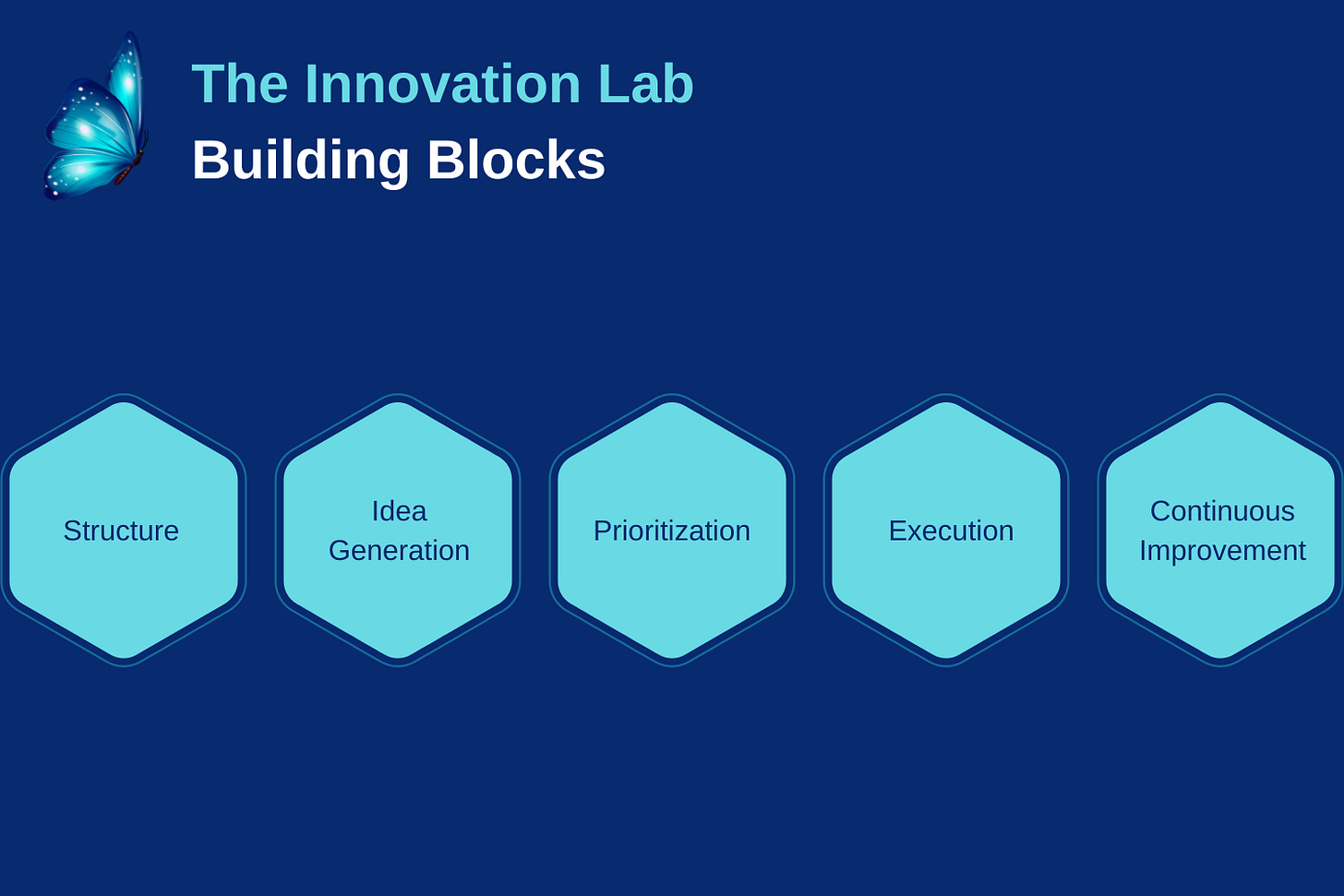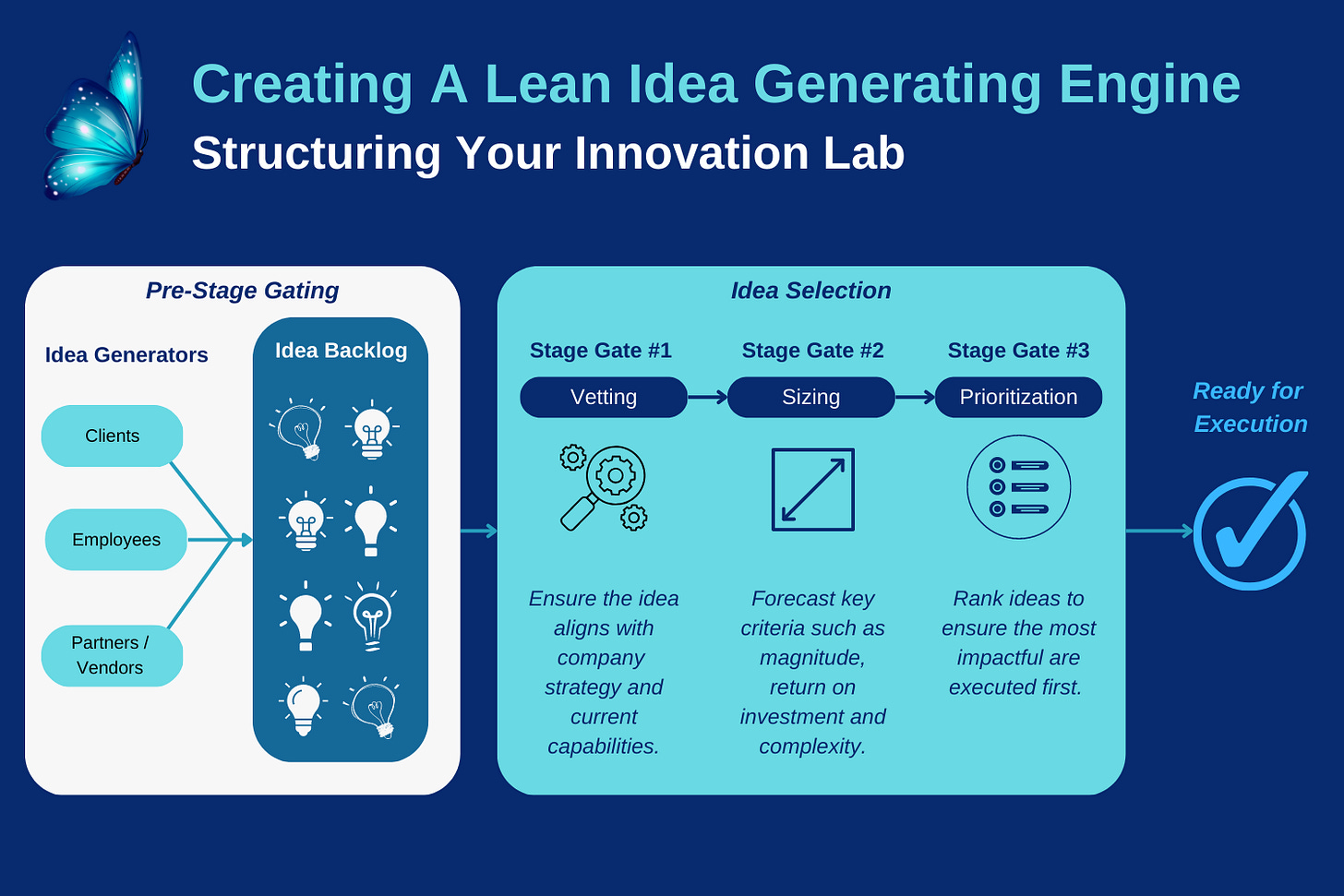Innovation Labs: Don't Just Create, Dominate
(#003)
Hi everyone. Get ready for an exciting deep-dive into creating your very own innovation lab. In this article, I’ll cover everything you need to know, including:
Defining what an innovation lab is and why it matters
5 practical steps to building your own from scratch
A real-world example from a tech company doing this at scale
In 2019, my fiancé and I embarked on a unique venture - the launch of Colossal Cookie Company. Our concept was simple yet powerful: an online-only cookie shop that delivered exceptionally delicious cookies straight to consumers, unbound by the constraints of a physical storefront. With a relentless pursuit of perfection, we aimed to create flavours that surpassed the ordinary and provided our customers with a seamless online ordering experience, free of any hassle.
At first, we found ourselves struggling to gain a foothold in a bustling marketplace teeming with cookie-crazed competitors. While we did catch a few lucky breaks here and there, steady growth remained frustratingly elusive. It was like trying to stand out in a room full of baking enthusiasts armed with nothing but a mixer and an oven.
But my partner and I refused to give up. Along with our marketing manager, we started a new process. One that helped us brainstorm and generate fresh ideas. We met for two hours every week and let our imaginations run wild. From mind mapping to creative exercises, we did whatever it took to spark new concepts and push ourselves further.
And then, we had a breakthrough.
During one of these brainstorming sessions, we uncovered a surprising insight about our customers. While poring over transaction data, we found that nearly 40% of them were actually buying our cookies as gifts for their loved ones and clients - not for themselves! This unexpected discovery led us down a rabbit hole of investigation, and we soon realized that this group of gift-givers had specific needs and preferences, from gift notes to better packaging. We knew we had stumbled upon a golden opportunity to elevate our business and cater to this untapped market. It was our 'aha!' moment.
Fast forward to today, and we're proud to be known as the go-to brand for delicious, stunning gifts across North America. Our custom-engineered packaging is top-notch, and we've added all sorts of extras like ribbons, greeting cards, and more to make each order feel special. We've finally found our niche, and we're excited to keep pushing ourselves further as we grow.
Size doesn't matter when it comes to innovation. Take our small business, for example - we may not be a global conglomerate, but we've learned a thing or two about the power of a formalized idea generation process. And we're not alone. Companies of all shapes and sizes are realizing that innovation is no longer a 'nice-to-have', it's a necessity for survival in today's fast-paced business world.
Enter the innovation lab - a space where creativity can flourish, experimentation is encouraged, and failure is celebrated. From tech giants like Apple and Google to sportswear titans like Nike, the world's most successful companies have harnessed the power of innovation labs to drive growth and stay ahead of the competition.
With nearly a decade of experience working with companies that have successfully established and expanded their own innovation labs, I'm excited to share the strategies that work. If you're ready to blaze a trail in your industry instead of following in someone else's footsteps, it's time to consider setting up your own innovation lab. And I'm here to guide you every step of the way.
The Definition
Innovation labs are as unique as snowflakes – no two are exactly alike. Every company has its twist on what constitutes such a lab. While this diversity is great, let's define the concept so that we're on the same page.
At its core, an innovation lab is a standalone entity within a company, dedicated to creativity and innovation. Its members have one focus: to uncover, cultivate and promote new ideas that can revive their business strategies. These strategies may involve creating new revenue streams or refining existing ones, and the innovation lab is the catalyst that makes them happen.
Got it so far? Great, because we're just getting started. Let's dive into the nitty-gritty details of creating a tailor-made innovation lab for your organization.
A Priority For Growth
Having an innovation lab may give you bragging rights among your network, but the truth is that succeeding with one is no easy feat. Many labs end up being absorbed into a closely-tied function within the organization, which comes with its own set of advantages and disadvantages:
Let's start with the good news:
Fewer roadblocks mean that ideas can come to fruition much more quickly.
Key decision makers who have a stake in the innovation lab's success are more likely to support it.
The lab can align its roadmap with the organization's overall strategy, making it easier to get buy-in.
Now some not-so-great aspects to consider:
Idea generation is often limited to the function that houses the lab, making it harder to get fresh perspectives.
It can create the impression that only a select few staff members are capable of creativity.
There may be some bias at play since there's no objective viewpoint at the organization level to oversee the lab's operations.
Innovation labs that dominate are not tied to a function that holds them back. That means giving it a seat at the big boys' table - the one where all the strategy discussions happen. When your lab has a bird's eye view of the opportunities and risks facing your organization, it can truly unleash its creative potential and generate game-changing ideas. And don't worry about bias or subjectivity - with an objective and transparent approach, your innovation lab can rise to the challenge and make a real difference.
Take a peak at an org chart that has innovation as a priority.
Can you see how powerful this could be? By breaking free from the confines of a single function, your innovation lab can become a powerhouse of creative thinking and strategic vision. With the freedom to operate transparently and objectively, your lab can generate ideas that have the power to shake up the industry, drive innovation, and even transform your entire business model.
From Vision to Reality: Five Steps for Building Your Innovation Lab
Your innovation lab is more than just a shiny new addition to your org chart - it's the key to unlocking your organization's full potential. With its unique perspective and direct connection to leadership, your lab is poised for greatness. But getting it up and running is only the beginning of the journey. This is the moment where innovative ideas move beyond mere concepts and become real-world solutions.
As you embark on the exciting journey of building out your lab, remember that the market you're targeting is your very own organization. So you want to make sure you get it right. No sweat - I've developed a five-step approach that's proven to be effective in streamlining the process, which is as follows:
Structuring your innovation lab
Scaling idea generation
Prioritizing the best ideas
Bringing ideas to life
Creating a culture of continuous improvement
Let’s go into each one in fine detail.
1. Structuring Your Innovation Lab
Want to build an innovation lab that truly sparks creativity and fuels progress? Here's a secret: keep bureaucracy out of the equation. The team's precious time and energy should be focused on generating and executing game-changing ideas - not getting bogged down by politics and red tape. When you cut the barriers to innovation, the possibilities are endless.
But let's be honest - it's easier said than done. That's why I believe in building the right roles to create an unstoppable idea engine that propels the company forward. We start by assembling a diverse team that's open to every function in your organization, not just a select few. Rather than dedicating everyone to the innovation lab 100%, we encourage a culture of empowerment that allows all employees to contribute their ideas and time when the opportunity arises, with an allotment that makes sense for them.
So, let's dive into each of the key roles that make up a successful innovation lab:
Vice President, Innovation: This is the linchpin of your lab, overseeing the entire function and ensuring that it's fully integrated into the company's operations. Their responsibilities include managing the intake of ideas, setting clear KPIs, tracking progress, and ultimately ensuring that approved projects are successfully delivered.
Don't make the mistake of promoting anyone less than a Vice President to lead your innovation efforts. This signals a lack of commitment to true transformation through innovation. You need a seasoned executive to navigate the complex landscape and ensure that every aspect of the business is positively impacted.
The VP is the only role I recommend to be 100% dedicated to the lab.
Agile Program Manager: Another key player in your innovation lab is the Agile Program Manager. This person is all about making things happen - taking strategy, prioritization, and teamwork and turning them into a tangible product, service, or process. Working closely with the VP of Innovation, the Agile Program Manager needs to have a keen understanding of the big picture while being willing to get their hands dirty to accomplish the work.
But don't be fooled by the title - the best person for the role is methodology agnostic, able to execute with excellence regardless of the project at hand. This means being flexible and adaptive, able to adjust as needed to ensure success. In addition to overseeing day-to-day operations, the Agile Program Manager will also be responsible for facilitating huddles that shape ideas and bring them to life.
One of the most critical aspects of this role is staying objective, unbiased, and transparent. It's essential that the Agile Program Manager maintains an impartial perspective, ensuring that decisions are made with the best interests of the project at heart.
The Idea Generator: The secret to scaling your organization's innovation lab. With this game-changing role, anyone in the company can pitch their ideas - from the newest intern to the most seasoned executive.
Once an idea is submitted, The Idea Generator is responsible for everything from the pitch to building its value proposition. Commitment and dedication are needed right from the start. Employees who want to take on this role must be sure they have the bandwidth for it.
The Idea Committee: While brainstorming is important, not every idea is a gem. That's where this group of experts comes in - they're responsible for evaluating which concepts should move forward to the next phase.
Composed of roughly 5-7 subject matter experts and influential figures from various areas of the organization, the Idea Committee meets regularly to review pitches submitted to the innovation lab. This powerhouse team includes thought leaders from product development, marketing, engineering, and other key departments who will determine if a new idea is worth investing time and resources into.
Why is the Idea Committee essential? They ensure ideas align with the company's strategy, spot potential opportunities, and mitigate risks. Plus, they'll give each idea a thorough analysis. With their expertise, only the best ideas will advance.
The Project Team - The force that brings approved ideas to life. Composed of a dynamic and ever-changing group of individuals, they are responsible for executing and delivering the product, service, or process that originated from the idea.
The Project Team works closely with the Agile Program Manager to overcome obstacles, build, release, and test with precision. Although anyone can become a team member, the idea generator is typically a required member.
These dedicated professionals are the backbone of the innovation process, ensuring approved ideas are transformed into a tangible reality.
With a better understanding of the key roles in an innovation lab, let’s switch gears to see how we can set the Idea Generators up for success.
2. Scaling Idea Generation
Exceptional companies are those that possess the rare trait of being great listeners. They not only keep their ears to the ground to hear the pulse of the market, but also pay keen attention to their employees. If you’re working for a company with such a forward-thinking approach, you’re one of the lucky ones.
So, what does such a company listen for? Ideas, of course! Who better to mine fresh perspectives and new opportunities from their existing work than their own employees? When designing your innovation lab, it’s essential to create a process that makes it easy for employees to submit their innovative ideas and become Idea Generators. An open, easy-to-use idea intake form is a fantastic way to start.
Here’s a possible set of steps you could take to make this happen:
Set up an online form for idea submission and store the data in a database for vetting purposes. Google Forms is a great, easy way to get started fast.
Spread the word that everyone is welcome to generate ideas throughout the organization.
Empower employees to generate innovative ideas by providing them with supporting documentation that simplifies the process and reduces friction. This could include flowcharts, playbooks, and other resources that make it easy to contribute ideas.
Excitement will be high when you introduce The Idea Generator role, resulting in many new ideas. To keep things valuable, provide guidelines to keep ideas focused on your company's strategy.
3. Idea Selection
It all starts with a great idea. But let's face it, not all ideas are created equal. To succeed, you need to vet, size, and prioritize them. That's where the idea committee comes in.
Their job is to review every idea and supporting material to determine if it's worth pursuing. But here's the thing: not every idea is going to make the cut. And that's okay. It's all about finding the ones that will help the business achieve its goals.
So, how do you do that? Let's take a closer look at the three stages of idea evaluation:
Stage Gate 1: The Idea Committee works closely with the Idea Generator to review the idea and supporting materials, such as client interest and the business case. The goal at this stage is to determine whether the idea is viable and worth pursuing. There's no need to size the idea yet - it's all about getting alignment.
Stage Gate 2: Each idea is weighed against an objective, predetermined set of criteria. While most functions prioritize the least risky endeavor, an innovation lab measures risky bets against other criteria such as strategy alignment, magnitude of the opportunity, and other relevant factors. I recommend a scorecard in Excel or Google Sheets, with each criteria measured on a scale of 1 to 5, and only the ideas that meet a certain quantifiable threshold make it through this stage gate.
Stage Gate 3: The remaining ideas are lined up and sorted as the committee discusses one question: which ideas can we realistically start and complete first? Objectivity is key as the team looks over resourcing, current capabilities, and potential return on investment. The goal is to drive new paths for the business and make a meaningful impact.
It seems like we have a good working system in place where ideas become projects. Now, how do we turn projects into finished products?
4. Execution
The transition from theory to practicality is where the rubber meets the road. It's the stage where the team comes together to create something tangible, and it's a critical part of the innovation process. While I could delve into this topic extensively, I'll keep it concise by listing some key considerations below:
Agile thinking is crucial. Work in short bursts while still having a clear understanding of the end goal. The idea was approved for a reason, but the specific features and components may not have been fully fleshed out. Your job is to align with the vision and gradually refine it until you reach the finish line.
Regular team meetings are essential. Hold daily standups to discuss new ideas, roadblocks, and successes. Collaboration and innovation go hand in hand, so involve the Agile Program Manager and the VP if necessary.
Test and get feedback often. The Idea Generator should be involved in all testing phases, and it's a good idea to seek outside opinions as well. You want a tight feedback loop, so the work being built is consistently moving towards the right goal.
Evaluate success. Once the project is complete, it's time to take a step back and assess the success metrics. While completing the work may be fulfilling, the true measure of success lies in achieving the value that the innovation team envisioned from the outset.
5. Continuous Improvement
Innovation isn't just about staying ahead of the competition; it's about consistently outdoing them. And what better way to gain a lasting edge than by looking inwards?
The most successful innovation labs embrace the art of making mistakes. They understand that each misstep is a chance to learn and grow, bringing them one step closer to the correct path. The labs that fail? They shy away from errors, leaving them with zero opportunities to improve.
To truly foster a culture of continuous improvement, you must instill it in the DNA of every team member inside and outside the innovation lab. And don't wait for the perfect moment - it's better to make mistakes when the stakes are lower, even if there's capital tied to it.
So, how do you build such a culture? It contains a few key integrations:
Hold Retrospectives: Whether you choose to incorporate sprints or not, you'll definitely want to schedule regular review cycles to assess what's working and what needs improvement. During these sessions, you'll collaborate with your team to tackle three vital questions: what should we keep doing, what should we stop doing, and what should we start doing? This provides valuable feedback to the entire project team, including the Agile program manager and VP, ensuring that all necessary changes are made throughout the entire project lifecycle.
Keep Communication Open: This isn’t a fairytale. We want to ensure everyone is open to express concerns, issues and risks without fear. We don’t want a bunch of sugar coating to happen. Open and transparent communication will take the group much further along than keeping it internal.
Turn Mistakes Into Fortune Telling: Imagine being able to predict future roadblocks for your organization and having the solutions already at your fingertips. If you've made a mistake in a project, it's likely that someone else will make the same mistake in the future. So, why not use it to your advantage? With powerful software tools like Notion, Microsoft Notes, or Confluence, you can easily create a lessons learned repository to ensure continuous improvement and successful delivery of future innovation projects. Your organization will benefit from your foresight and you'll be able to confidently tackle any challenges that come your way.
Proactive Risk Takers: When it comes to the boldest ideas, you'll want to be prepared for any outcome. That's why a pre-mortem is an essential step to take. Picture this: a meeting with your top players where you collectively imagine the worst-case scenario for your project. By asking the team, "What would cause this project to fail spectacularly?" you can effectively identify any potential roadblocks before they even become a problem. With pre-mortems, you can give your team the upper hand by addressing risks head-on and crafting contingency plans before the project even begins.
Always remember that continuous improvement is an essential part of the innovation process. It's the foundation that gives you a competitive edge and ensures that you stay ahead of the curve. Incorporating it into your innovation lab from the very beginning will help you achieve success and maintain your position as a leader in your industry.
An Example
To wrap up this article, I'd like to share one of my all-time favourite examples of a company that truly knows how to run an innovation lab - Samsung and their Product Innovation Team, also known as PIT. What makes PIT so exceptional are the following key aspects we've discussed throughout this article:
They foster a culture where making mistakes is not just tolerated but encouraged, as it paves the way for groundbreaking innovations.
They prioritize diversity in their team, recognizing that different perspectives drive innovation and creativity.
They value agility, enabling them to think and act fast to bring new ideas to life.
They maintain a close feedback loop to ensure that the ideas they pursue are viable and scalable.
They understand that generating ideas is just the beginning - the real magic happens when they identify the right ones and execute them successfully.
If you'd like to see these principles in action, check out this quick video.
In today's world, disruption has become the norm, and being proactive is a prerequisite for effective leadership. To achieve hyper-growth and explore new avenues for success, leaders must go beyond traditional approaches. The establishment of an innovation lab is one of the most effective ways for leaders to take charge and pave the way for better ways of doing things.






